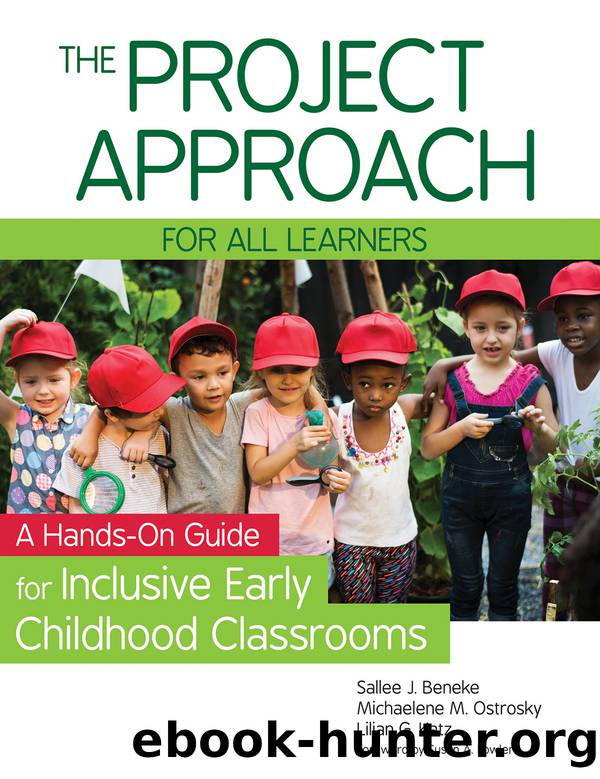The Project Approach for All Learners by Unknown

Author:Unknown
Language: eng
Format: epub
Tags: EDUCATION / Preschool & Kindergarten, EDUCATION / Inclusive Education, EDUCATION / Teaching Methods & Materials/General
Publisher: Brookes Publishing
Published: 2018-10-10T00:00:00+00:00
Figure 4.1.Mrs. Utz brought in a sprinkler, which sparked her childrenâs curiosity about gardening.
Provide Materials to Support Experimentation
Teachers can encourage exploration and experimentation by providing materials associated with the project topic that can be acted on by the children. Consider materials that can be touched, smelled, heard, weighed, measured, mixed, mashed, folded, cooked, cut, assembled, or disassembled. For example, in the Dog Project, Ms. DeLuca and Ms. Burd placed a collection of furs and fur-like fabrics on a table for the children to touch and compare (see Figure 4.2). In the Garden Project, Mrs. Utz planned opportunities for children to repot plants into larger containers. In the process, they explored the structure of each plant and the properties of potting soil (see Figure 4.3). In the Library Project, Ms. Harrison borrowed a scanner from the local library. She also borrowed a set of wooden shelves that the children could refer to as they considered building their own set. This allowed Ms. Harrison to bring important aspects of the shelves to the childrenâs attention. Watch Video 4.1 to see how Ms. Harrisonâs class drew plans for a bookshelf using a real shelf as a reference.
Support Understanding Through Props for Dramatic Play
Dramatic play typically takes place in the housekeeping center of the classroom. Other classroom centers, such as blocks, manipulatives, outdoor play, and art areas, can lend themselves to dramatic play as well. Dramatic play helps children understand the roles of people and materials related to the project topic; pretending to use dog grooming tools might help a child understand the importance of proper equipment for dog care, whereas pretending to use a watering can might help a child understand that water is important for plant growth. Teachers can spark this type of play by providing props such as hats, uniforms, equipment, tools, signs, and images in these centers. As teachers observe childrenâs play, they can provide additional props in response to emerging play themes. For example, Ms. Burd and Ms. DeLuca initially developed pet care areas in their housekeeping centers. Over time, this area in Ms. DeLucaâs room evolved into a pet store, whereas this area in Ms. Burdâs room became a veterinarianâs office. As they became increasingly involved in the Dog Project, second graders from Ms. Lavinâs class set up a rotation so that several second graders could spend time with their preschool buddies every day. The second graders and their preschool friends spent time exploring the topic in the early childhood dramatic play areas. The second graders modeled and encouraged their partners to engage in more advanced levels of play. Teachers can give children a role in planning additions or making changes to dramatic play. For example, as depicted in Video 4.2., when one of Ms. Harrisonâs students suggested that they move the class book stand to make it part of their library, Ms. Harrison took her suggestion seriously and encouraged other children to help move the stand.
Download
This site does not store any files on its server. We only index and link to content provided by other sites. Please contact the content providers to delete copyright contents if any and email us, we'll remove relevant links or contents immediately.
| Behavioral Disorders | Communicative Disorders |
| Gifted Students | Inclusive Education |
| Learning Disabled | Mentally Disabled |
| Physically Disabled |
The Art of Coaching Workbook by Elena Aguilar(50022)
Trainspotting by Irvine Welsh(20935)
Twilight of the Idols With the Antichrist and Ecce Homo by Friedrich Nietzsche(18261)
Fangirl by Rainbow Rowell(8743)
Periodization Training for Sports by Tudor Bompa(7884)
Change Your Questions, Change Your Life by Marilee Adams(7314)
This Is How You Lose Her by Junot Diaz(6398)
Asking the Right Questions: A Guide to Critical Thinking by M. Neil Browne & Stuart M. Keeley(5316)
Grit by Angela Duckworth(5260)
Red Sparrow by Jason Matthews(5164)
Paper Towns by Green John(4750)
Room 212 by Kate Stewart(4697)
Ken Follett - World without end by Ken Follett(4409)
The Sports Rules Book by Human Kinetics(4041)
Housekeeping by Marilynne Robinson(4014)
Double Down (Diary of a Wimpy Kid Book 11) by Jeff Kinney(3867)
Papillon (English) by Henri Charrière(3866)
The Motorcycle Diaries by Ernesto Che Guevara(3751)
Exercise Technique Manual for Resistance Training by National Strength & Conditioning Association(3747)
